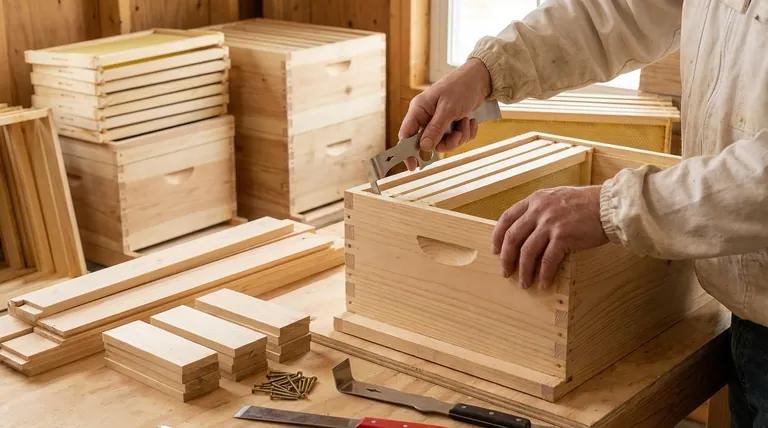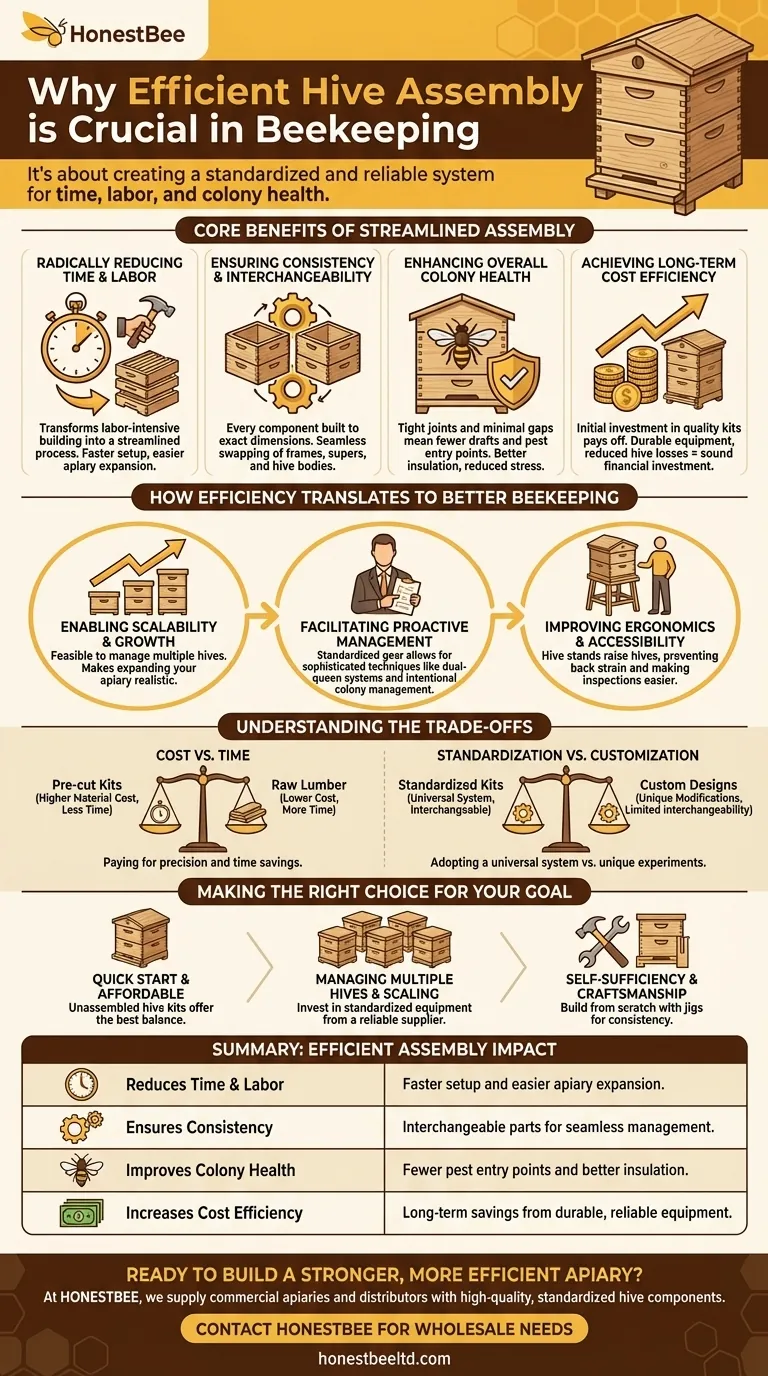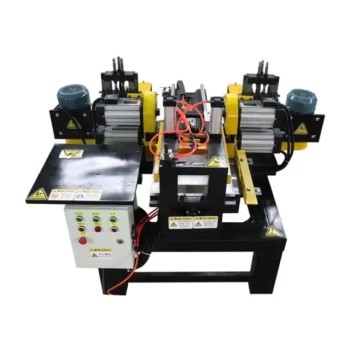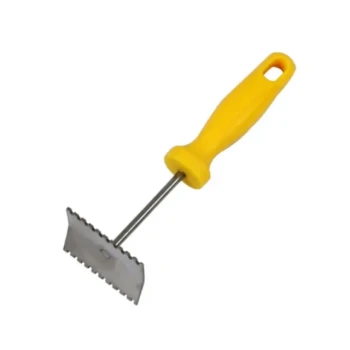In short, efficient hive assembly is crucial because it directly impacts a beekeeper's most valuable resources: time, labor, and the health of their colonies. It transforms the labor-intensive task of building hives into a streamlined process, resulting in consistent, interchangeable equipment that makes managing bees more accessible, productive, and cost-effective in the long run.
The core principle is this: efficient assembly isn't about building boxes faster, it's about creating a standardized and reliable system. This foundation of consistency allows you to focus your energy on the art of beekeeping, not the frustration of mismatched equipment.

The Core Benefits of Streamlined Assembly
A well-thought-out assembly process provides immediate, tangible advantages that ripple through your entire beekeeping operation. It moves beekeeping from a craft-heavy hobby to a more manageable and scalable practice.
Radically Reducing Time and Labor
Building a beehive from raw lumber requires significant time, skill, and precision. Even for experienced woodworkers, this can take hours per box.
Efficient assembly, often using pre-cut kits or jigs, dramatically cuts down this time. This makes the startup phase of beekeeping less daunting for novices and allows veteran keepers to expand their apiaries more easily.
Ensuring Consistency and Interchangeability
This is perhaps the most critical benefit. When every hive body, super, and frame is built to the exact same dimensions, they become interchangeable.
This consistency is vital for common management tasks like swapping frames of brood to equalize hive strength, combining weak colonies, or replacing damaged equipment without issue.
Enhancing Overall Colony Health
A precisely assembled hive has tight joints and minimal gaps. This structural integrity means fewer drafts and entry points for pests like wax moths or small hive beetles.
A sound structure provides better insulation and a more secure environment, reducing stress on the colony and allowing the bees to focus on brood-rearing and foraging.
Achieving Long-Term Cost Efficiency
While buying quality hive kits may seem more expensive upfront than using scrap wood, they provide better value over time.
The time saved, the durability of properly constructed equipment, and the reduction in hive losses due to poor housing make efficient assembly a sound financial investment.
How Efficiency Translates to Better Beekeeping
The initial benefits of a good assembly process directly enable more advanced and proactive beekeeping strategies. Your equipment starts working for you, not against you.
Enabling Scalability and Growth
Efficient assembly makes it feasible to have more than one hive. A second hive is invaluable as "insurance" against losing a colony and provides a crucial point of comparison for learning.
When you can assemble new hives quickly and reliably, expanding your apiary from a hobby to a larger operation becomes a realistic goal.
Facilitating Proactive Hive Management
Standardized equipment opens the door to more sophisticated techniques. For example, versatile hive designs allow for dual-queen systems, making on-site splits, or reconfiguring hives for honey production versus pollination.
When your gear is predictable, you can manage your colonies with intention rather than reacting to problems caused by faulty equipment.
Improving Ergonomics and Accessibility
A complete hive setup includes more than just the box. Components like hive stands are essential for raising the hive off the damp ground and making it harder for pests to enter.
Crucially, a stand also brings the hive to a more comfortable working height, preventing the back strain that can make inspections difficult and discouraging. This ergonomic consideration is a key part of an efficient and sustainable system.
Understanding the Trade-offs
While the benefits are clear, it's important to approach this with an objective viewpoint. There are always trade-offs to consider when choosing your method.
Initial Cost vs. Time Investment
Purchasing pre-cut, unassembled kits has a higher material cost than sourcing and cutting your own lumber.
You are essentially paying for precision and time savings. For most beekeepers, this trade-off is heavily in favor of buying kits, as their time is better spent managing the bees.
Standardization vs. Customization
Using standardized kits, such as the common Langstroth hive, means you are adopting a universal system.
This limits your ability to make unique modifications or experiment with different designs. However, for the vast majority of beekeepers, the benefits of universal interchangeability far outweigh the desire for customization.
Making the Right Choice for Your Goal
Your approach to hive assembly should align with your specific beekeeping objectives.
- If your primary focus is starting quickly and affordably: Unassembled hive kits offer the best balance, providing precision-cut parts that reduce labor while keeping costs lower than fully assembled hives.
- If your primary focus is managing multiple hives or scaling up: Invest in standardized equipment from a single, reliable supplier to guarantee that all components are perfectly interchangeable across your entire apiary.
- If your primary focus is self-sufficiency and craftsmanship: Building from scratch is a valid path, but create jigs to ensure every part you make is identical, preserving the crucial benefit of consistency for future growth.
Ultimately, treating hive assembly as a strategic process, not just a construction project, sets the stage for a more successful and enjoyable beekeeping journey.
Summary Table:
| Benefit of Efficient Assembly | Key Impact |
|---|---|
| Reduces Time & Labor | Faster setup and easier apiary expansion. |
| Ensures Consistency | Interchangeable parts for seamless hive management. |
| Improves Colony Health | Fewer pest entry points and better insulation. |
| Increases Cost Efficiency | Long-term savings from durable, reliable equipment. |
Ready to build a stronger, more efficient apiary?
At HONESTBEE, we supply commercial apiaries and beekeeping equipment distributors with high-quality, standardized hive components through our wholesale-focused operations. Our durable, precision-made equipment ensures the consistency and reliability your business depends on, saving you valuable time and labor while promoting superior colony health.
Contact HONESTBEE today to discuss your wholesale needs and discover how our supplies can help your operation thrive.
Visual Guide

Related Products
- HONESTBEE Advanced Ergonomic Stainless Steel Hive Tool for Beekeeping
- Professional Dual-End Stainless Steel Hive Tool for Beekeeping
- HONESTBEE Premium Italian Style Hive Tool with Hardwood Handle
- Wholesales Dadant Size Wooden Bee Hives for Beekeeping
- Professional Stainless Steel J-Hook Hive Tool
People Also Ask
- What is the hole in a hive tool for? A Multi-Tool for Apiary Repairs and Maintenance
- What are the basic tools for beekeeping? Essential Starter Kit for Safe & Successful Hive Management
- Why do hive tools have a hole? Unlock the Secret to Efficient Beekeeping
- What tools are used for cleaning frames? A Beekeeper's Simple 4-Tool Guide
- What are some common uses of a hive tool? Essential Multi-Purpose Tool for Every Beekeeper



















